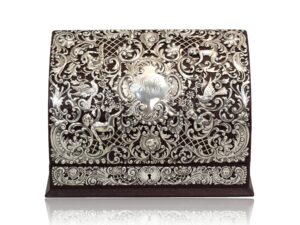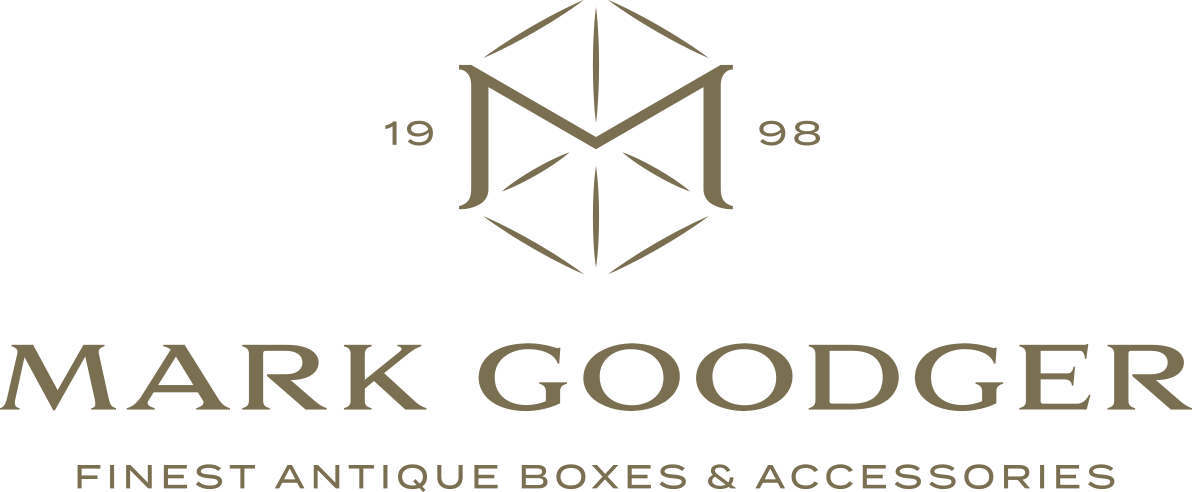Black Starr & Frost
Black Starr & Frost were originally founded as Marquand and Co. by Connecticut silversmith Isaac Marquand circa late 18th century at 166 Broadway, New York. The company grew significantly in the early 19th century and was continued in 1824 by Isaac’s son Frederick after he returned from a failed silver business he set up in Savannah, Georgia with his cousin, Josiah Penfield. The company became known as the most prominent Jewellers in New York City during the Gilded Age. Initially Marquand and Co. created a large selection of silver products from full tea services to large silver ewers and smaller pairs of useable table accessories. The turned to becoming primarily retailers in high end silver outsourcing the manufacture process to other silversmiths. In 1838 after servicing as President of Marquand and Co. Frederick sold the company to former apprentices William Black and Henry Ball. The new owners changed the name to Black, Ball, and Co. In 1839 the company was sold again to incorporate Henry Ball, Erasmus Tompkins and William Black and was renamed Ball, Tompkins & Black for 12 years until 1851 when it became Ball, Black & Company. Ball, Black & Company opened a new retail store at the intersection of Brodway and Price Street in New York City 9 years late in 1860. The company acquired the name Black, Starr & Frost when it introduced new partners Cortland Starr and Aaron Frost in 1876 and then merged with Gorham Manufacturing Company in 1929 becoming Black, Starr & Frost – Gorham. The new partnership flourished and they opened a newly remodelled building at Fifth Avenue and 48th street on October 30th 1929. The name was eventually styled as Black Starr Frost Gorham but later reverted to Black, Starr & Frost in 1960.
American Eagle Hallmark was used by Black Starr & Frost to certify their products. They were the first firm to use the American Eagle as its logo in the USA and clients knew the firm was “at the sign of the golden eagle.”
Black Starr & Frost
Black Starr & Frost were originally founded as Marquand and Co. by Connecticut silversmith Isaac Marquand circa late 18th century at 166 Broadway, New York. The company grew significantly in the early 19th century and was continued in 1824 by Isaac’s son Frederick after he returned from a failed silver business he set up in Savannah, Georgia with his cousin, Josiah Penfield. The company became known as the most prominent Jewellers in New York City during the Gilded Age. Initially Marquand and Co. created a large selection of silver products from full tea services to large silver ewers and smaller pairs of useable table accessories. The turned to becoming primarily retailers in high end silver outsourcing the manufacture process to other silversmiths. In 1838 after servicing as President of Marquand and Co. Frederick sold the company to former apprentices William Black and Henry Ball. The new owners changed the name to Black, Ball, and Co. In 1839 the company was sold again to incorporate Henry Ball, Erasmus Tompkins and William Black and was renamed Ball, Tompkins & Black for 12 years until 1851 when it became Ball, Black & Company. Ball, Black & Company opened a new retail store at the intersection of Brodway and Price Street in New York City 9 years late in 1860. The company acquired the name Black, Starr & Frost when it introduced new partners Cortland Starr and Aaron Frost in 1876 and then merged with Gorham Manufacturing Company in 1929 becoming Black, Starr & Frost – Gorham. The new partnership flourished and they opened a newly remodelled building at Fifth Avenue and 48th street on October 30th 1929. The name was eventually styled as Black Starr Frost Gorham but later reverted to Black, Starr & Frost in 1960.
American Eagle Hallmark was used by Black Starr & Frost to certify their products. They were the first firm to use the American Eagle as its logo in the USA and clients knew the firm was “at the sign of the golden eagle.”
Showing the single result

